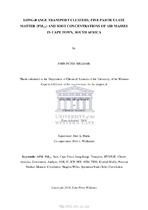Long-range transport clusters, fine particulate matter (PM2.5) and soot concentrations of air masses in Cape Town, South Africa
Abstract
Ambient air pollution is the biggest environmental threat to human health. According to the World Health Organisation (WHO), ambient air pollution kills millions of people worldwide every year. Airborne particulate matter (APM) affects more people than any other air pollutant and has been linked with various adverse health outcomes, especially fine fractions (commonly abbreviated to PM2.5). PM2.5 penetrates lung tissue to enter the cardiovascular system where it poses the greatest risk. Detailed ambient APM studies are rare in Africa. Such studies are needed to better understand the characteristics, origins and trends of particulate pollution. This study was conducted in Cape Town (the first of its kind for the area) as part of a bigger project on ambient PM2.5 and soot concentrations in South Africa. PM2.5 filter samples were collected at a fixed sampling site in the suburb of Kraaifontein from April 2017 to April 2018, yielding 121 days of data. PM2.5 mass concentration and absorption coefficient determinations were done using gravimetric analysis and smoke stain reflectometry (SSR). Mean PM2.5 concentration for the study period was 13.4 ± 8.1 μg.m-3 (range: 1.17-39.1 μg.m-3) that fell below the South African National Ambient Air Quality Standard (SA NAAQS) annual limit of 20 μg.m-3 but exceeded the WHO annual limit of 10 μg.m-3. Mean absorption coefficient for the same period was 1.38 ± 1.23 m-1.10-5 (range: 0.00-5.38 m-1.10-5) which did not exceeded any limits. Source-region analyses were performed using single, 24-hour backward trajectories and trajectory clusters derived from the Hybrid Single Particle Lagrangian Integrated Trajectory (HYSPLIT) model. Six single trajectories were identified; the most frequent were trajectories Atlantic-Ocean (38.8 %) and Indian-Ocean (26.4 %). Cluster analyses yielded three to four clusters per season. Dominating clusters were Atlantic-Ocean (61.8 %) and Indian-Ocean (29.5 %) and Inland (8.50 %). Contributions by local sources (within 40 km of the sampling site) to PM mass in samples far exceeded those of distant sources through long-range transport (LRT).

